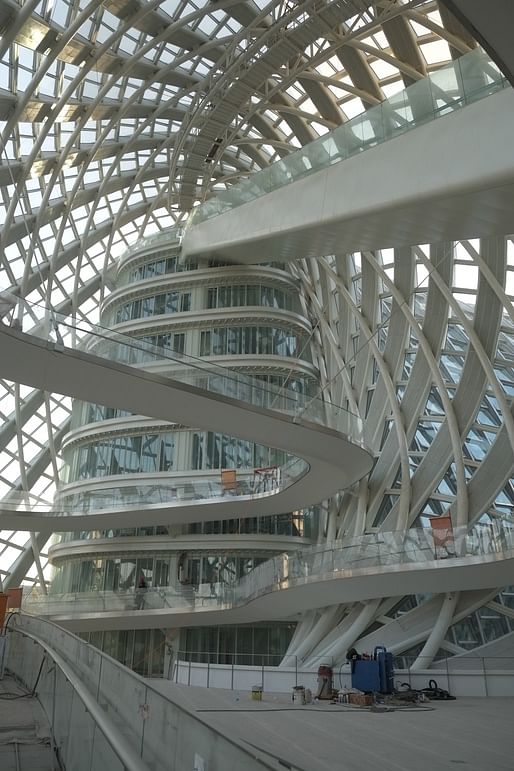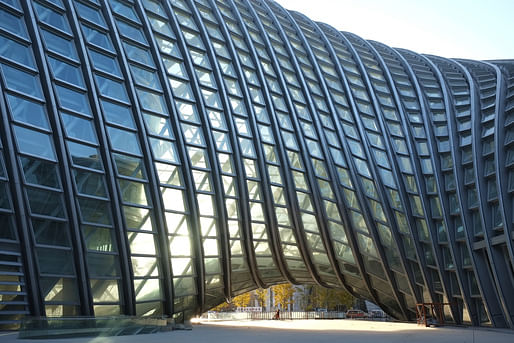
 A group of our students joined in with architecture students from other universities in Beijing, to visit the Phoenix International Media Center. This building, designed by the Beijing Institute for Architecture Design (BIAD), with Shao Weiping as the leading architect, is housing China's biggest private broadcasting company, and is due for completion later this year. We were shown around by Danni Wang, architect at the BIAD on November 6, 2013. The project is the first locally design-built parametric project by Chinese architects and engineers. With the integration of BIM and parametric design processes in the work flow, the project represents an up-to-date approach to design and building, burgeoning in the industry.
A group of our students joined in with architecture students from other universities in Beijing, to visit the Phoenix International Media Center. This building, designed by the Beijing Institute for Architecture Design (BIAD), with Shao Weiping as the leading architect, is housing China's biggest private broadcasting company, and is due for completion later this year. We were shown around by Danni Wang, architect at the BIAD on November 6, 2013. The project is the first locally design-built parametric project by Chinese architects and engineers. With the integration of BIM and parametric design processes in the work flow, the project represents an up-to-date approach to design and building, burgeoning in the industry.
 The Phoenix International Media Centre emerges from the southwest corner of Chaoyang Park as a new landmark in its background of sameness. The ascension in building height from the north to south demonstrates a sensitivity to the residences in the north and creates a presence facing the street. The southern entrance welcomes the public into the interior surrounding the media houses as well as into the courtyard space between the two blocks. It could be argued however, that public space allocation is excessive as functions are not clearly defined, especially in areas like the courtyard. But whether or not this is true can only be judged when the building becomes operational.
The Phoenix International Media Centre emerges from the southwest corner of Chaoyang Park as a new landmark in its background of sameness. The ascension in building height from the north to south demonstrates a sensitivity to the residences in the north and creates a presence facing the street. The southern entrance welcomes the public into the interior surrounding the media houses as well as into the courtyard space between the two blocks. It could be argued however, that public space allocation is excessive as functions are not clearly defined, especially in areas like the courtyard. But whether or not this is true can only be judged when the building becomes operational.
 Conceptually, the program works as a building-in-a-building by defining the spatial relationships with an outer shell for the public areas and an inner thermal mass for the media house. The repetition of the structural members, along with the flyover ramps and platforms gives the building added dimension and interest to the interior.
Conceptually, the program works as a building-in-a-building by defining the spatial relationships with an outer shell for the public areas and an inner thermal mass for the media house. The repetition of the structural members, along with the flyover ramps and platforms gives the building added dimension and interest to the interior.
Comparisons in the form of the Phoenix International Media Centre and the Bird’s Nest have been made. However there is an expression of disapproval by the architects, as unlike its predecessor, all structural members in the Phoenix International Media Centre are for support and not aesthetics.
 Each structural steel member is a continuous loop along the cross-section, tied at the base and secured at the top by a service bridge that acts as a counter-balance to wind forces. Fixed to this structure, is the overlapping facade which double as the frame for the glazing and the housing for the MEP.
Each structural steel member is a continuous loop along the cross-section, tied at the base and secured at the top by a service bridge that acts as a counter-balance to wind forces. Fixed to this structure, is the overlapping facade which double as the frame for the glazing and the housing for the MEP.
The ‘fish scale’ concept of the facade allowed for a significant reduction in the price of using curved glass pieces, but posed a challenge in maintaining the fluidity the designers strived for. As a result a physical model was built to ensure all kinks were addressed and every glass piece given a different dimension.
As a new prominent building that will come to represent the Chaoyang area and Beijing, the Phoenix International Media Centre is impressive in representing China’s position in the field of architecture. There is a clear indication that rigour and attention to details were critical in the completion and potential success of this project.
In the School of Architecture at Tsinghua University, Beijing, the English Program for Master Architecture (EPMA) provides a nationally accredited post-professional program in integrated architectural design. It combines a global network with local implementation. The program is focused on the construction of the human habitat, and the application of advanced building technologies.
No Comments
Block this user
Are you sure you want to block this user and hide all related comments throughout the site?
Archinect
This is your first comment on Archinect. Your comment will be visible once approved.